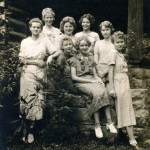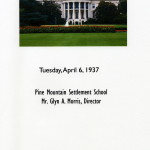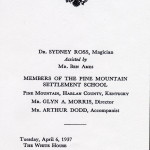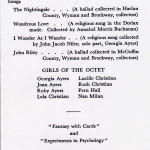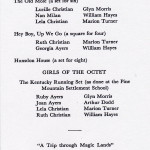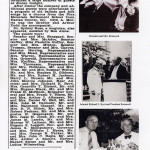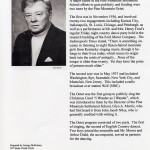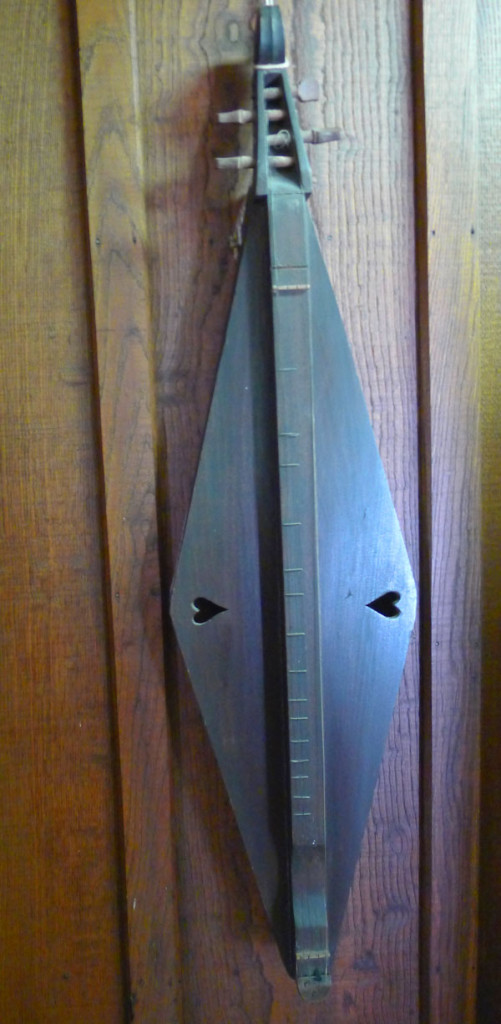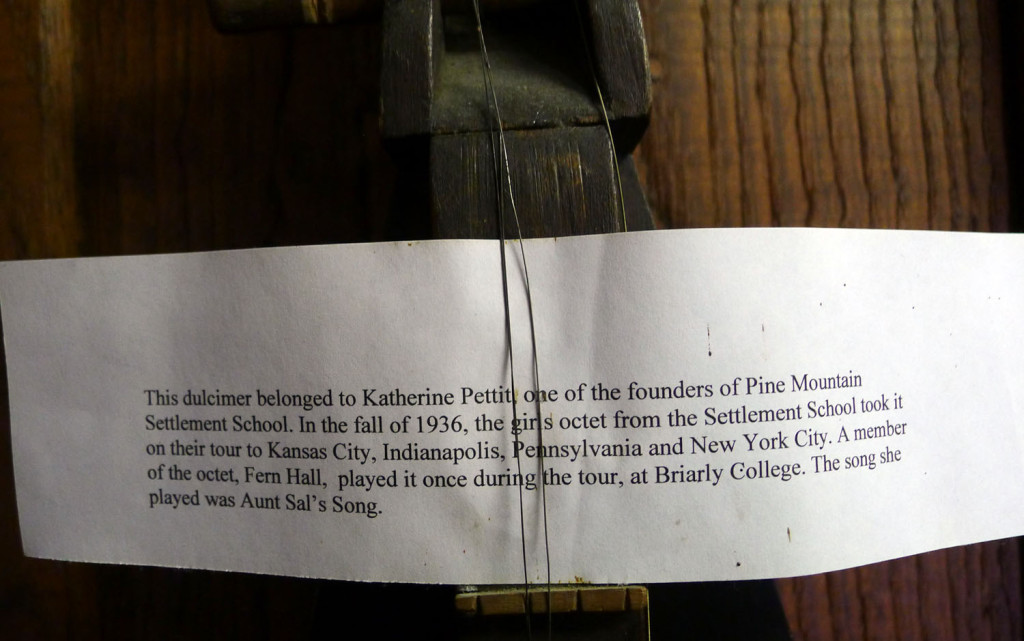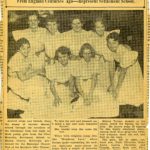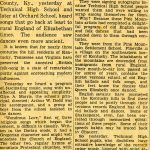Pine Mountain Settlement School
Series 30: MUSIC AND DANCE
BY TOPIC – MUSIC AND DANCE
PMSS Girls Octet
1936-1938
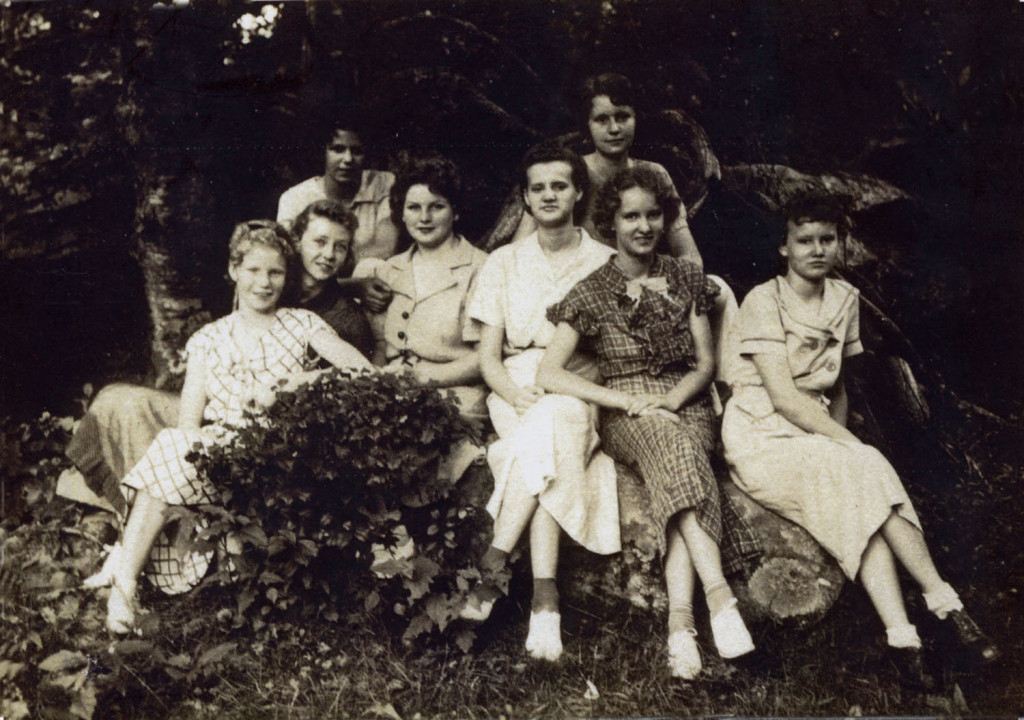
PMSS Octet members, 1937. (l-r) Lucille Christian ; Fern Hall ; Lela Christian ; Nan Milan ; Georgia Ayers ; Ruth Christian ; Joan Ayers ; Ruby Ayers [octet_01a001_mod.jpg]
TAGS: PMSS Girls’ Octet, principals of democracy, promotional tours, Roosevelt White House performance, newspaper articles, benefit performance tours, mountain ballads and songs, English country dancing, the Kentucky running set
MUSIC PMSS Girls’ Octet 1936-1938
“We have learned much from our experience as we have tried to extend the principles of democracy into all areas of school life. There has been anxiety on the part of some of us about the place of democracy and its meaning in a school such as Pine Mountain. As a staff we have sometimes been confused but we are coming slowly to realize that democracy means, among other things, delegated responsibility.”
— Glyn Morris
PROMOTIONAL TOUR 1937
In 1937 the director of Pine Mountain Settlement School, Glyn Morris, assembled a group of students to take them on a 4,000-mile promotional tour. The group included eight young women from the School who formed an octet. This group sang ballads and songs typical of the Southern Appalachian mountains and often specific to the Pine Mountain valley in Harlan County, Kentucky.
In addition to the eight women, there were two men, Marion Turner and William Hayes, who traveled with the group, as well as a musician and the director, forming a group of twelve. The men served as dancers for a program of English Country dancing and for the Kentucky Running Set, a dance form unique to the area.
CONTENTS: PMSS Girls’ Octet 1936-1938
A description of the PMSS Octet promotional tour in 1937. [3 images of members]
Transcriptions of two reports on the 1936 and 1937 PMSS Octet tours as told to George McKinney, son of Lucille Christian (McKinney), one of the Octet members: “Roosevelt White House Entertainment” and “The Octet.” [2 images]
Description of two newspaper articles covering the 1936 PMSS Octet tour in Cincinnati, Ohio. Transcription of one of those articles.
A description of the PMSS Octet benefit performance tours in 1938. detailing the November performance at the Town Hall in New York, NY.
A description of Katherine Pettit‘s mountain dulcimer that was taken with the PMSS Octet on the 1938 tour and played by Fern Hall, an Octet member. [2 images]
Transcription of the program for the 1937 PMSS Octet performance at the White House. [4 images]
Transcription of April 7, 1937, New York Times article reporting the PMSS Octet performance at the White House. [1 image]
Recordings by Alan Lomax of Octet in 1937 for Library of Congress (list incomplete):
When Walking Out One Sunday Morning (fragment) http://lomaxky.omeka.net/items/show/550
Pretty Polly (fragment) http://lomaxky.omeka.net/items/show/548
Wonderous Love http://lomaxky.omeka.net/items/show/549
John Reilly http://lomaxky.omeka.net/items/show/449
GALLERY: PMSS GIRLS’ OCTET 1937 Program, Press Article, & White House Report
- PMSS Octet members, 1937. (l-r) Georgia Dodd, Lucille Christian, Nan Milan, (seated) Fern Hall, Joan Ayers, Ruth Christian, Lela Christian, Ruby Ayers [pmss_octet0002a_mod]
- PMSS Octet program, 1937, page 01. [PMSS_ser31_oct0002b]
- PMSS Octet program, 1937, page 02. [PMSS_ser31_oct0002c.jpg]
- PMSS Octet program, 1937, page 03. [PMSS_ser31_oct0002d.jpg]
- PMSS Octet program, 1937, page 04. [PMSS_ser31_oct0002d.jpg]
- PMSS Octet press article, 1937. [PMSS_ser31_oct0002f.jpg]
- PMSS Octet at White House, 1937, page 01. [PMSS_ser31_oct0002g.jpg]
- PMSS Octet at White House, 1937, page 02. [PMSS_ser31_oct0002h.jpg]
TRANSCRIPTIONS: 1936 & 1937 Tour Reports by George McKinney
The following reports of the Octet visit to the Roosevelt White House and the tour of the Octet to other venues were prepared by George McKinney, son of Lucille Christian McKinney and was shared with Pine Mountain in December of 2007.
ROOSEVELT WHITE HOUSE ENTERTAINMENT
The Roosevelts held two musicales a month, from December to April, in the East Room of the White House. Musicales Lasted about an hour and a half. During the last half hour light refreshments were served on a large round table placed in the transverse hall outside the Blue Room. Preparations for the events were fairly simple. Gilded bent-wood chairs were brought down from the attic. A platform was set up in the north end of the East Room and covered with carpeting. The room was decorated with palms, and the curtains were closed. The guests entered through the east wing, ascending by the stair to the state floor, where aides showed them to the East Room. Except for the first two rows, seating was general. The Roosevelts entered to trumpets immediately before the entertainment.
At the end of the entertainment, with the guests still seated in the East Room, each of the entertainers was introduced to President Roosevelt, who chatted with one of the boys (Marion Turner) about some property in eastern Kentucky in which his family had an interest. Mrs. Roosevelt accompanied the group to the dining room, making sure all were comfortable before she retired to be with the guests.
Mr. Henry Junge of Steinway and Sons, who would have been 77 years old at the time of this event, made the arrangements with the entertainers, a function he had performed for all the First Ladies beginning with Mrs. Taft. Edith Helm, Secretary to Mrs. Roosevelt, coordinated the arrangements at the White House.
Prepared by George McKinney
[Son of Lucille Christian McKinney, one of the Octet members]
THE OCTET [1936 & 1937 TOURS]
Two tours by the Pine Mountain Octet were a major factor in the Pine Mountain Settlement School efforts to gain publicity and funding. The first was in November 1936, and involved twenty-two engagements including Kansas City, Indianapolis, St. Louis, Chicago, and Pittsburgh, as well as a performance at Mr. and Mrs. Henry Ford’s regular Friday night country dance party held in the research building of the Ford Motor Company. The Indianapolis Times stated, “There is something uncanny in listening to eight flaxen-haired mountain girls from Kentucky singing music, though it belongs to their lives today, which traces its origin back into the mists of antiquity… None of the troupe is older than twenty. Yet they have the poise of persons much older.”
The second tour was in May 1937 and included Washington, Rye, Scarsdale, New York City, and Montclair, New Jersey. This included a radio broadcast over station WJZ (NBC). The Octet was the first group to publicly sing the Christmas carol “I Wonder as I Wander”, which was introduced to them by the Director of the Pine Mountain Settlement School, Glyn A. Morris, who had first heard it from John Jacob Niles, who is generally credited with writing it.
The Octet program consisted of two parts. The first of singing; the second of English Country dances. Two boys joined the ensemble and Mr. Morris and Arthur Dodd, the accompanist, served as partners for the dancing.
Prepared by George McKinney
[Son of Lucille Christian McKinney, one of the Octet members]
1936 Octet Tour – Newspaper Articles
“Damsels in Ancient Dances! Kentucky Mountain Girls Also Sing Songs Brought To This Country From England Centuries Ago — Represent Settlement School”
The Enquirer, Cincinnati, Ohio, 1936
The article appeared in The Enquirer of Cincinnati, Ohio, and describes a concert for the Episcopal Church Club of the Southern Ohio Diocese at the Cincinnati Club in November of 1936. The songs and ballads in the concert were reported as “sad tunes from rural England of the seventeenth and eighteenth centuries which have been preserved in remote sections of the Kentucky mountains because of their very remoteness …”
Glyn Morris, Pine Mountain’s director said to the reporter that the concert, ” … is none of that hill-billy stuff …”. Selections such as ‘John Riley,’ an ancient ballad discovered in McGoffin County, KY, and ‘Wonderous Love,’ a very ancient ballad, were sung.
Accompanied by the pianist from the School, Arthur Dodd, the girl’s Octet were joined by boys, Marion Turner and William Hayes, and the group’s leader, Glyn Morris, filled in to complete a set for the performance of traditional English dances. The English Country Dances, some as early as the seventeenth century, included, ‘Heartsease’, ‘Hey Boys, Up We Go, ‘Bag Pipe’s Jig,’ and ‘Old Mole,’ — a favorite of the dancers. A unique dance form from Kentucky — the ‘Kentucky Running Set’ — was also performed but without music, as was traditional. Marion Turner, the student, called the figures for the set. The intricate dance followed figures named for their patterns, such as : ‘Grapevine Twist’, ‘Four-a-Square,’ Shoot the Owl,’ and ‘Bird in a Cage.’ Marion Turner, it was reported, knew “some 20 figures from this highly emotional dance.”
The Cincinnati concert was part of the lengthy tour taken by the Octet and dancers in the Fall of 1936 and included other locations such as Detroit where the group was invited to join the industrialist Henry Ford in a dance party at his home. Ford, an admirer of English Country Dance, joined the group when they performed and by all accounts was an accomplished folk dancer. He also demonstrated his latest car model which was due to be released the following day and invited members of the group to sit behind the wheel of the new model. The students were chaperoned by Mrs. Howard Burdine, wife of the Pine Mountain School farmer, as well as Director Glyn Morris and pianist Arthur Dodd.
________________________________________________________________
“Mountain Troupe Plays ‘Fascinating’ Music
Indianapolis Times, Nov. 11, 1936
Prior to leaving for their [1936] tour the group performed for the Harlan County Technical High School and again at Orchard School in the home county.
Two articles, one by James Thrasher and another by Joe Collier appeared in the Indianapolis Times. The copy in the articles echoes much of what appeared in the Cincinnati Inquirer as it was prepared for the tour. James Thrasher remarked: “There is something uncanny in listening to eight flaxen-haired girls from Kentucky singing music which, though it belongs to their lives today, traces its origin back into the mists of antiquity.”
In this preliminary concert, the program is described as including ‘Wonderous Love,’ and two other “religious songs,” that “bore the stamp of more local influence. The second group of songs included ‘John Riley,’ ‘The Nightingale,’ ‘The Deaf Woman’s Courtship,’ and ‘I Wonder When I Shall Be Married,’ which “appeared to have received their texts, at least, in this country.”
In this program, six dances were also performed, including the ‘Sword Dance,’ which was described as evolving from a “religious ritual of pre-Christian Britain.” The dancers “moved through the intricate patterns with grace and beauty.”
James Thrasher, the reporter, notes that, “Those who search after a ‘true’ American music experience might well turn to the collectors of these interesting items for a fund of practically untouched melody.”
Joe Collier begins his report:
“Autograph! Autograph! One hundred Technical High School students flocked around, holding out programs for signatures, insisting on them.
Clark Gable? Carol Lombard?
No. Eight girls from Pineville [sic —he got it wrong!] Ky. born in Kentucky, reared in Kentucky, and out of the Kentucky mountains for the first time. [not really!]
They were signing autographs because Technical High School people wanted them and were willing to scrap among themselves for them.
Why? Because these Pine Mountain artists had completed a delightful program of old English songs and folk dances that had been handed down to then through centuries.
They were from the Pine Mountain Settlement School. Pineville [sic – No, not Pineville in Bell County, which is not near Pine Mountain Settlement School] is a village on the southeastern border of Kentucky. The inhabitants of the mountains are descended from immigrants from rural England. Their mouth-to-ear lore, passed on for scores of years, contains the purest versions extant of old English ballads and folk songs, and their feet know the dances that Queen Elizabeth once danced.
English savants have journeyed to the Kentucky hills to find these people and to purify through their versions records England has of its old ballads and dances. Some of Shakespeare, even, has been corrected through memorized quotations of these people. Some of their speech habits may be traced back to Chaucer.
So, yesterday, Technical High School pupils who doubtless have extensive knowledge of the current swing music, listened with quiet attention to quaint hymns, and watched without a noise the folk dances.
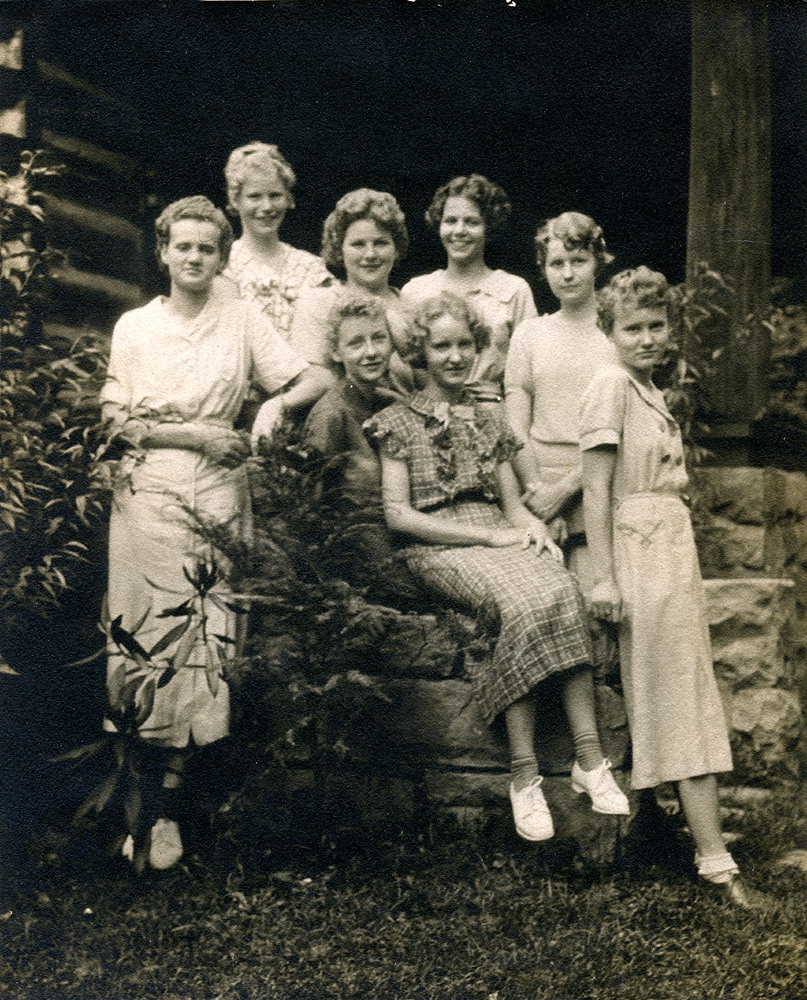
PMSS Octet, c. 1937. Georgia Ayers ; Lucille Christian ; Nan Milan ; Fern Hall and Joan Ayers (seated) ; Lela Christian ; Ruth Christian ; Ruby Ayers. [pmss_ser31_oct0001.jpg]
PMSS Girl’ Octet 1936-1938: 1938 Octet Tour
In November of 1938 students again gave benefit performances in Kansas City, Pennsylvania, Indianapolis and New York City. Many of the same 1936 group were called on to join the later benefit performances.
On November 21, 1938, the group performed at Town Hall in New York. The program included the Kentucky Running Set with the students as well as several other related groups including a performance of ballads, madrigals, and folk songs by the Madrigal Society of Brooklyn, a series of Instrumental Arrangements of English and American Folk Music that included Pine Mountain students, and Country, Morris, and Sword Dances by the English Folk Dance and Song Society of America.
Planned by the friends of Pine Mountain in New York and the other locations, the performances were to raise money for the School and to give visual evidence of the interests of the School which included the revival of folk material and the “innate culture” of the area. The program noted,
From the beginning Pine Mountain has been conscious of the wealth of folk material in the locality. The school has been a center for an artistic revival of this innate culture and has fostered an appreciation of English forms, in song and dance, which are the background of this pioneer inheritance, Folk songs and folk dances are a natural and delightful part of the daily life, reaching their climax in the May Day Festival at the school. The children sing Bach but also the mountain ballads, and the traditional country dances are their popular recreation.
Dulcimer Performance – 1938 Octet Tour
Dulcimer once owned by Katherine Pettit, PMSS Co-Founder, and now part of PMSS Archive Collection. [dulcimer-P1050419.jpg]The mountain dulcimer was taken with the Octet on the 1938 New York City, Kansas City, Pennsylvania, and Indianapolis tour. Fern Hall. a member of the Octet, played the dulcimer on the tour and sang “Aunt Sal’s Song,” a song that was a favorite of Sally Creech, wife of Uncle William Creech. The dulcimer is still on display at Pine Mountain Settlement School.
“This dulcimer belonged to Katherine Pettit one of the founders of Pine Mountain Settlement School. In the fall of 1936, the girls octet from the Settlement School took it on their tour to Kansas City, Indianapolis, Pennsylvania and New YOrk City. A member of the octet, Fern Hall, played it once during the tour, at Briarly College. The song she played was Aunt Sal’s Song. ”
“This dulcimer belonged to Katherine Pettit one of the founders of Pine Mountain Settlement School. In the fall of 1936, the girl’s octet from the Settlement School took it on their tour to Kansas City, Indianapolis, [IN], Pennsylvania, New York City. A member of the octet, Fern Hall played it once during the tour at Briarly College.”
The song Fern played [and sang] (September 7, 1937) was Bashful Courtship, also known as Aunt Sal’s Song .
Label attached to Miss Pettit’s dulcimer, describing its use by the Octet. [dulcimer_mod_P1050422.jpg]. “Aunt Sal’s Song” may be found in the 1923 publication in the PMSS Archive – PINE MOUNTAIN SONG BALLADS AND OTHER SONGS.
TRANSCRIPTION: Program for the 1937 Octet Performance at the White House
PMSS Octet Program, 1937, page 01 [PMSS_ser31_oct0002b.jpg]
Tuesday, April 6, 1937
Pine Mountain Settlement School
Mr. Glyn A. Morris, Director
PMSS Octet Program, 1937, page 02 [PMSS_ser31_oct0002c.jpg]
Dr. SYDNEY ROSS, Magician
Assisted by
Mr. BEN AMES
MEMBERS OF THE PINE MOUNTAIN
SETTLEMENT SCHOOL
Pine Mountain, Harlan County, Kentucky
Mr. GLYN A. MORRIS, Director
Mr. ARTHUR DODD, Accompanist
———-
Tuesday, April 6, 1937
THE WHITE HOUSE
PMSS Octet Program, 1937, page 03 [PMSS_ser31_oct0002d.jpg]
PROGRAM
Songs
The Nightingale…(A ballad collected in Harlan County, Wyman and Brockway, collectors)
Wondrous Love...(A religious song in the Dorian mode. Collected by Annabel Morris Buchanan) [ http://lomaxky.omeka.net/items/show/549 ]
I Wonder As I Wander…(A religious song collected by John Jacob Niles; solo part, Georgia Ayers)
John Riley…(A ballad collected in McGoffin County, Wyman and Brockway, collectors)
GIRLS OF THE OCTET
Georgia Ayers………………………………………..Lucille Christian
Joan Ayers……………………………………………..Ruth Christian
Ruby Ayers…………………………………………….Fern Hall
Lela Christian…………………………………………Nan Milan
_____
“Fantasy with Cards”
and
Experiments in Psychology”
Dr. SYDNEY ROSS
PMSS Octet Program, 1937, page 04 [PMSS_ser31_oct0002d.jpg]
English Country Dances
The Old Mole (a set for six)
Lucille Christian………………………………………….Glyn Morris
Nan Milan…………………………………………………..William Hayes
Lela Christian……………………………………………..Marion Turner
Hey Boy, Up We Go (a square for four)
Ruth Christian……………………………………………Marion Turner
Georgia Ayer……………………………………………..William Hayes
Hunsdon House (a set for eight)
GIRLS OF THE OCTET
The Kentucky Running Set (as done at the Pine Mountain Settlement School)
Ruby Ayers………………………………………………Glyn Morris
Joan Ayers………………………………………………..Arthur Dodd
Lela Christian……………………………………………Marion Turner
Ruth Christian…………………………………………..William Hayes
____
“A Trip through Magic Lands”
Dr. SYDNEY ROSS
TRANSCRIPTION: April 7, 1937, New York Times article
[PMSS_ser31_oct0002f.jpg]
Large Number at White House
Special to THE NEW YORK TIMES.
WASHINGTON, April 6. — The President and Mrs. Roosevelt entertained a large number of guests at dinner tonight.
After dinner the company and additional guests were entertained by a program of old ballads and folk songs by a chorus from the Pine Mountain Settlement School from Harlan County, Ky. Glyn A. Morris was the director and Arthur Dodd the accompanist.
Dr. Sydney Ross, a magician, also appeared, assisted by Ben Ames.
The guests were:
Senator and Mrs. Sheppard, Senator and Mrs. McAdoo, Senator Guffey, Miss Pauletta Guffey, Senator and Mrs. Minton, Senator Truman, Senator and Mrs. Chaves, Senator Herring, Representative and Mrs. Mead, Representative and Mrs. Warren, Representative and Mrs. Griswold, Representative and Mrs. Kniffen, Representative and Mrs. Thomason, Representative and Mrs. Robinson, Mr. and Mr. West, Mr. and Mrs. Sumner Welles, Mr. and Mrs. Stephen B. Gibbons, Mr. and Mrs. Robert H. Jackson, Harry L. Brown, Mr. and Mrs. John Monroe Johnson, Rear Admiral and Mrs. Richard E. Byrd, Mrs. Grenville T. Emmet, Mr. and Mrs. Eugene Black, Mr. and Mrs. Frank R. McNinch, Brigadier General and Mrs. Frank T. Hines, Mr. and Mrs. Arthur J. Altmeyer, Mr. and Mrs. Daniel W. Bell, Mr. and Mrs. John M. Carmody, Mr. and Mrs. Raymond Clapper, Mr. and Mrs. R. N. Elliott, Mr. and Mrs. Robert Fechner, Mr. and Mrs. Augustus E. Giengengack, Mr. and Mrs. Jesse H. Jones, Mr. and Mrs. James M. Landis, Mr. and Mrs. Murray W. Latimer, Mr. and Mrs. Eugene . Leggett, Rev. and Mrs. James S. Montgomery, Governor and Mrs. William I. Myers, Mr. and Mrs. George B. Parker, Mr. and Mrs. John C. Regis, Mr. and Mrs. Arthur J. Sinnott, Herbert Bayard Swope and Mr. and Mrs. Lucius Wilmerding.
The New York Times
April 7, 1937
Copyright The New York Times
[Captions for photographs: “President and Mrs. Roosevelt”, “Admiral Richard E. Byrd and President Roosevelt” and “Harry Truman and President Roosevelt”.]
MORRIS AND THE OCTET
During the fifteen years that Glyn Morris led Pine Mountain’s programs, there was an explosion of cultural energy. Partially influenced by what has come to be known as the “Craft Revival” movement and specifically at Pine Mountain the revival work of Folklorist Evelyn Wells who worked at the School in the early years.
The visits by noted folklorists such as the famous English folklorist, Cecil Sharp who came to Pine Mountain in 1917, also left distinct influences and kept the School in the mainstream of folklore scholarship. From its beginning, Pine Mountain has engaged a rich cultural heritage that thrived in the oral culture of the Appalachians. The national promotion of the region’s ballad culture under the various Directors was from the beginning of the School an important part of its reputation.
Cecil Sharp said of his visit to the school:
“I had really begun to despair of ever finding in the mountains anyone handling the mountain people in the right way; that is, the way in which you are doing it. I shall never forget your children. I only hope that you may never be hindered for lack of material assistance, and what little I can do to further that, I shall do with enthusiasm.”
While Sharp’s monetary support of the school may not have been enthusiastic or not feasible, his influence and his research and writing continue to highlight the school’s role in modeling and promoting English balladry and dance and folkways in America. His attention to Pine Mountain was a special gift — or in the view of some — not.
Glyn Morris’ strong interest in mountain culture, the arts of dance, music, and theater were, however, encouraged by the national interest given to folk culture in the Appalachians. Morris gave the arts a central focus in his administration and in his administrative promotions. Under Morris music and dance played a major role in the educational life of the School. Morris’ cultural experiments engaged students in a variety of traditional folkways combined with academic activities and contemporary cultural activities.
English country dance and balladry continued the earlier traditions established by Ruth Bolles, Evelyn Wells, Abby Winch Christiansen, and other early workers at the school and became a powerful force in the social bonding of the school’s students and staff and, for many, a life-long memory and avocation. Today, the collections at the School represent one of the largest collections of folk music, dance and folklife in the state of Kentucky.
To this rich folk life cultural heritage, Morris also added contemporary theater, such as Gilbert and Sullivan’s Mikado and contemporary composers and music were brought to the school from progressive institutions such as Black Mountain College in North Carolina and from Louisville. Morris also introduced contemporary furniture design and woodworking, when Frank “Unk” Cheney was hired to head the woodworking shop. Cheney brought Eastern influences to the arts on campus and demonstrated the similarities of the crafts of the two cultures and how they could be aesthetically combined.
He encouraged creative writers, performers, and scholars to come for extended stays on the campus and to spread the work of the school through their research and publications. Alan Lomax came to the campus in September of 1937 and recorded traditional ballads and mountain musicians. These collections reside today in the John and Alan Lomax collections held by the Folk Life Collections of the Library of Congress in Washington DC.
Richard Chase of Jack Tales fame periodically came to the campus where, as part of the staff, he participated in school events while pursuing his own writing. It was a practice he continued for years after Morris’ departure. Many other visitors contributed to the diversity of the cultural climate at the School with programs that covered the breadth of ancient to contemporary. Morris was determined to connect the student’s cultural heritage with contemporary life, helping them to make sense of their cultural milieu.
When Morris took the institution to the nation in a series of concerts and performances throughout the northeast including a performance in the White House for President Roosevelt and his guests and a recording session at Radio City Music Hall by the Pine Mountain Girl’s Octet, he used the opportunity to extend the classroom into the contemporary world. The touring students performed for Henry Ford, in Detroit, danced in Chicago, Kansas City and New York and stretched their wings in ways few of them could even imagine — or, forget.
He wrote in his last report to the school’s Board of Trustees in December 1941, his reflections regarding the progress of the school in the ten years under his direction. Remarking on his vision for its future, he said
We have learned much from our experience as we have tried to extend the principles of democracy into all areas of school life. There has been anxiety on the part of some of us about the place of democracy and its meaning in a school such as Pine Mountain. As a staff we have sometimes been confused but we are coming slowly to realize that democracy means, among other things, delegated responsibility.
That the arts were part of Morris’ idea of “delegated responsibility” was one of the great gifts to students of the School and a responsibility that kept on giving.
GALLERY: PMSS Girls’ Octet 1936-1938, 2008
- 2008 [?] 4 members of Girl’s Octet. Lela Christian Meador; Georgia Ayers Dodd; Fern Hall Hayes; Lucille Christian McKinney. [octet_last_01x.jpg]
- 2008 [?] 4 members of Girl’s Octet. Lela Christian Meador; Georgia Ayers Dodd; Fern Hall Hayes; Lucille Christian McKinney. [octet_last_02x]
- PMSS Girls’ Octet. Newspaper clipping, part 1. [fern_0012x]
- PMSS Girls’ Octet. Newspaper clipping, part 2. [fern_0011]
SEE ALSO:
BIOGRAPHIES
FERN HALL Student Staff (Hayes)
GEORGIA AYERS Student Staff (Dodd)
JOANNA AYERS Student Staff (Houseman)
LELA CHRISTIAN Student (Meador)
LUCILLE CHRISTIAN Student (McKinney)
RUBY AYERS Student (Warren)
RUTH CHRISTIAN Student (Russell)
RELATED
ALAN and ELIZABETH LOMAX Visitors
CECIL SHARP AND MAUDE KARPLES Visit to PMSS
DANCING IN THE CABBAGE PATCH Dulcimers at Pine Mountain (Blog)
FLORENCE REEVES COLLECTION Ballads, Songs, Colloquialisms
NOTES – 1991 Fall, Page 3
PMSS Song Ballads and Other Songs 1923
|
Title |
Pine Mountain Settlement School Girl’s Octet |
|
Alt. Title |
The Girl’s Octet |
|
Identifier |
|
|
Creator |
Pine Mountain Settlement School, Pine Mountain, KY |
|
Alt. Creator |
Ann Angel Eberhardt ; Helen Hayes Wykle ; |
|
Subject Keyword |
Pine Mountain Settlement School Octet ; Pine Mountain Settlement School ; octets ; promotional tours ; benefit performances ; mountain troupes ; music ; ballads ; songs ; Marion Turner ; William Hayes ; dances ; dancers ; English Country Dance ; Kentucky Running Set ; Georgia Dodd ; Lucille Christian (McKinney) ; Fern Hall ; Lela Christian ; Nan Milan ; Georgia Ayers ; Ruth Christian ; Joan Ayers ; Ruby Ayers ; Glyn Morris ; George McKinney ; President Roosevelt ; Eleanor Roosevelt ; White House ; musicales ; Henry Junge ; Steinway and Sons ; Edith Helm ; Mr. and Mrs. Henry Ford ; Indianapolis Times ; radio broadcasts ; Christmas carols ; John Jacob Niles ; Arthur Dodd ; Episcopal Church Club ; Southern Ohio Diocese ; Cincinnati Club ; Mrs. Howard Burdine ; Harlan County Technical High School ; Orchard School ; Cincinnati Inquirer ; madrigals ; folk songs ; Madrigal Society of Brooklyn ; English Folk Dance and Song Society of America ; folk music revivals ; May Day ; mountain dulcimers ; Fern Hall ; Sally Creech ; Aunt Sal’s Song ; |
|
Subject LCSH |
Pine Mountain Settlement School Octet —Pine Mountain Settlement School. (Pine Mountain, Ky.) — History. |
|
Contributor |
Pine Mountain Settlement School, Pine Mountain, KY |
|
Type |
Collections ; text ; image ; |
|
Format |
Original and copies of documents and correspondence in file folders in filing cabinet |
|
Source |
Series 30: MUSIC AND DANCE |
|
Language |
English |
|
Relation |
Is related to: Pine Mountain Settlement School Collections, Series 30: MUSIC AND DANCE |
|
Coverage Temporal |
1936 – 1938 |
|
Coverage Spatial |
Pine Mountain, KY ; Harlan Co., KY ; Kansas City, KS ; Indianapolis, IN ; St. Louis, MO ; Chicago, IL ; Pittsburgh, PA ; Washington, DC ; Rye, NY ; Scarsdale, NY ; Montclair, NJ ; McGoffin County, KY ; Detroit, MI ; |
|
Rights |
Any display, publication, or public use must credit the Pine Mountain Settlement School. Copyright retained by the creators of certain items in the collection, or their descendants, as stipulated by United States copyright law. |
|
Donor |
n/a |
|
Description |
Core documents, correspondence, writings, and administrative papers of The Octet ; clippings, photographs, books by or about The Octet ; |
|
Acquisition |
n/d |
|
Citation |
Pine Mountain Settlement School Institutional Papers, Pine Mountain Settlement School, Pine Mountain, KY |
|
Processed By |
Helen Hayes Wykle ; Ann Angel Eberhardt ; |
|
Last Updated |
20014-02-23 hw ; 2018-04-15 hhw ; 2020-06-10 hhw ; 2020-07-29 hhw ; 2023-07-11 aae ; 2024-03-19 hhw ; |
|
Bibliography |
Sources The Lomax Kentucky Recordings, University of Kentucky [NOTE: The Library of Congress owns the original Alan Lomax recordings, but holds no copyright or intellectual property rights to these recordings. Some rights are held by the performers, and other rights may exist. For publication use, the American Folklife Center asks patrons to make a good faith effort to contact rights holders and deposit written permission at AFC. AFC facilitates this process, providing what contact information it has. AFC recommends that queries relating to publication be forwarded to AFC. By entering these pages, all users of the Alan Lomax Kentucky recordings agree that they will indemnify and hold the University of Kentucky/Berea College and its affiliates, employees, faculty members, members of its governing boards and agents harmless from and against any claims, losses, liabilities, damages, costs and expenses including reasonable attorneys’ fees arising out of or relating to the making of the Alan Lomax Kentucky recordings or their use of them, or their breach of any other provision of this agreement. “Damsels in Ancient Dances! : Kentucky Mountain Girls Also Sing Songs Brought To This Country From England Centuries Ago — Represent Settlement School,” The Enquirer, Cincinnati, Thursday, November, 1936. Print “Mountain Troup Plays ‘Fascinating’ Music.” Indianapolis Times, November 11, 1936. Print Program. “Benefit Performance, Monday Evening, November 21, 1938, Town Hall, New York.” Archival material. |
Return To:
MUSIC and DANCE Guide

